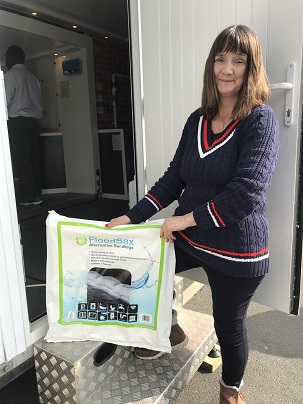 Flood campaigner Mary Dhonau with a pack of 5 FloodSax alternative sandbags
Flood campaigner Mary Dhonau with a pack of 5 FloodSax alternative sandbags
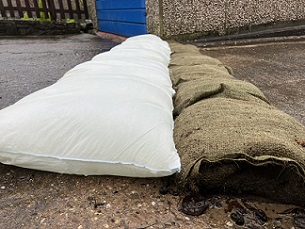 A line of FloodSax alternative sandbags next to a row of old-style sandbags
A line of FloodSax alternative sandbags next to a row of old-style sandbags
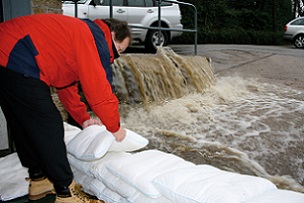 FloodSax sandless sandbags are robust enough to keep out a torrent of floodwater
FloodSax sandless sandbags are robust enough to keep out a torrent of floodwater
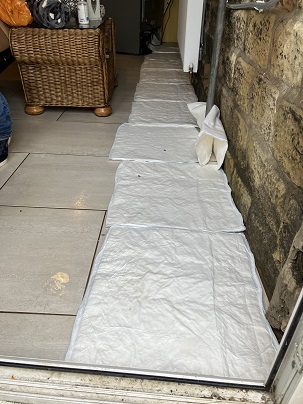 FloodSax in their dry state can soak up any floodwater which seeps into your home or business, preventing further damage
FloodSax in their dry state can soak up any floodwater which seeps into your home or business, preventing further damage
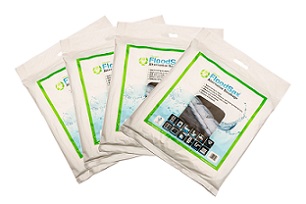 FloodSax alternative sandbags are very space-saving to store and quick and easy to deploy
FloodSax alternative sandbags are very space-saving to store and quick and easy to deploy
Full list of areas in UK to get flood prevention funding from the Government
The Government has pledged £100m to try to protect areas of the UK which suffer from repeated flooding.
The first 53 projects have been revealed which will be allocated more than £26m to better protect more than 2,300 households and businesses across the country.
The money can be used to buy flood doors and barriers, especially in places where it’s not possible to build bigger flood defence schemes.
If flood doors are installed the advice from one of the country’s leading flood experts is to use them with FloodSax alternative sandbags as flood gates can still let water get through.
Mary Dhonau, who is affectionately known as Mary Queen of Floods, says: “To get the flooding kite mark, anti-flood devices must not leak more than a litre of water in an hour.”
This means that water can and does leak in through many anti-flood devices.
Mary is a flood victim turned flood crusader who is now the ‘go to’ expert on flooding and is often touring the country in her floodmobile showing people the best ways to prevent flooding.
And she has shared her ultimate flooding prevention 1, 2, 3.
Step 1: Have a specialist flood door to prevent the water getting in but be aware that most doors won’t stop all the water from seeping through.
Step 2: Put FloodSax alternative sandbags on the floor inside the door to soak up any water that does get in. In their dry state, FloodSax are ultra-thin with a large surface area so are ideal at absorbing any floodwater.
Step 3: Invest in a portable water pump to get rid of any floodwater in your home or business quickly down to 1mm … and then use FloodSax (www.floodsax.co.uk) again to soak the rest up.
FloodSax are well-known as alternative sandbags – just immerse them in water and they absorb up to 20 litres of it to expand so they resemble traditional sandbags – but in their dry state they are great at soaking up water from leaks, spills and floods indoors.
The fact that they can be used both indoors and outdoors makes them one of the most flexible and value-for-money anti-flood devices on the market.
The government’s £100m Frequently Flooded Allowance scheme targets communities where 10 or more properties have flooded twice or more in the last 10 years.
Environment Minister Rebecca Pow said: “We know only too well the devastating impact that flooding can have on communities and businesses as we face more extreme weather brought about by climate change.”
Caroline Douglass, Executive Director for Flood and Coastal Risk Management at the Environment Agency, added: “Increased flooding is just one of the impacts of climate change we are seeing in the UK and around the world. Protecting people and communities is our top priority as we look to tackle this challenge.”
The full list of projects to receive funding are:
- Alconbury Flood Alleviation Scheme Stage 2
- Brighton & Hove City Council Surface Water Management Feasibility Study
- Bingley and Shipley Property Flood Resilience Study
- Bledington Flood Alleviation Scheme
- Brighouse Flood Alleviation Scheme
- Burrow Beck Conveyance Improvements
- Carlisle Appraisal Package Appleby Town Centre
- Chard Flood Alleviation Scheme
- Cocker Beck, Lowdham, Flood Alleviation Scheme
- Dufton Close Feasibility Study
- Earby Flood Alleviation Scheme Phase 3, Earby Beck
- Eardisland Flood Alleviation Scheme
- Erringden Hillside
- Falmouth Integrated Urban Drainage Management
- First Avenue Flood Alleviation Scheme
- Flood Risk Reduction Schemes 2 - Copley Village Flood Alleviation Scheme
- Flood Risk Reduction Schemes 2 - Cottonstones near Lumb, Calderdale
- Flood Risk Reduction Schemes 2 - Railes Close between Luddenden and Midgley
- Greyfriars Community Flood Risk Management Scheme
- Hebden Bridge Flood Alleviation Scheme
- Ilminster Flood Alleviation Study
- Intake, Flood Risk Management Scheme
- Irwell Vale to Chatterton
- Langstone (Havant) Flood and Coastal Erosion Risk Management Scheme
- Larkspur Close Integrated Urban Drainage Scheme
- Lavendon Flood Alleviation Scheme
- Leintwardine and Walford Property Flood Resilience
- Lindale Road Grange over Sands
- Lipson Vale Phase 1, Trefusis Park (South West Water Integrated Urban Drainage Modelling)
- Little Bollington River Bollin Property Flood Resilience
- Market Weighton Flood Alleviation Scheme
- Natural Flood Management Upstream of Cirencester
- Northumbria Integrated Drainage Partnership - Redcar (Yearby, Kirkleatham & Low Farm Drive, and West Dyke Road) Flood Alleviation Scheme
- Northumbria Integrated Drainage Partnership - Saltburn (Princes Road & Marske Road) Flood Alleviation Scheme
- North Road, Holme Village Flood Alleviation
- Pallion Flood Alleviation Scheme
- River Teme, Tenbury Wells Community Flood Alleviation Scheme
- Rolleston Brook Flood Alleviation Scheme, Staffordshire
- Ruislip Park Wood and Pinn Meadows
- Severn Stoke Flood Alleviation Scheme, River Severn
- Skipton Road
- Small Communities Property Flood Resilience Scoping
- South Cave Flood Alleviation Scheme
- Stony Stratford Flood Alleviation Study
- Stubbing Holme Road
- Tenbury Wells Integrated Flood Solution
- Toronto Close Flood Alleviation Scheme
- Undefended Properties in the Ironbridge Gorge - Individual Property Protection
- Upper River Piddle Catchment Flood Risk Management Scheme
- Walsden Flood Alleviation Scheme
- West End Road, St Helens
- Whitley Brook Flood Reduction Scheme
- Williton Flood Alleviation Study